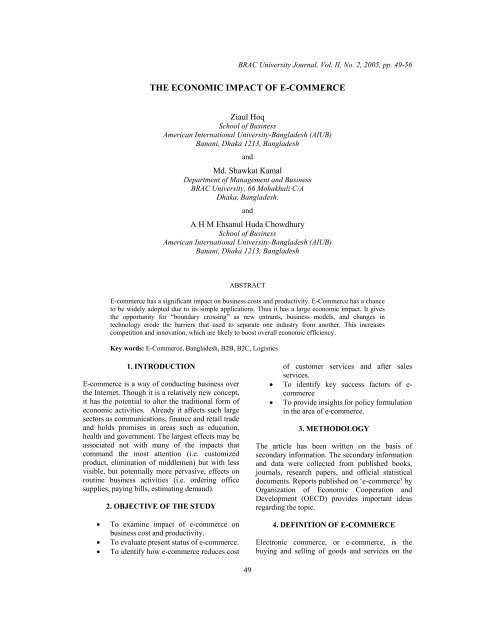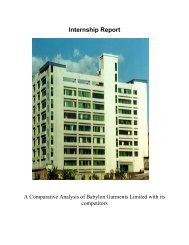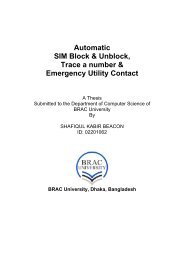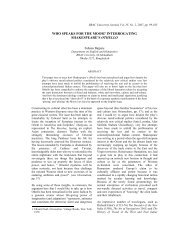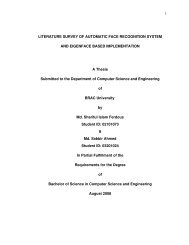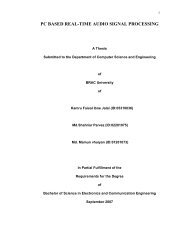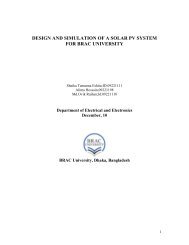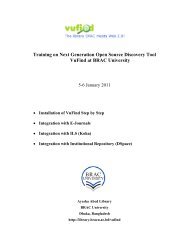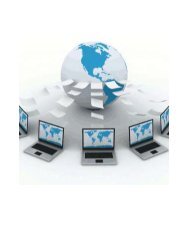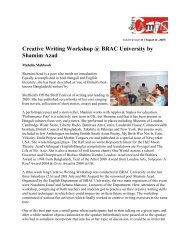the economic impact of e-commerce - of DSpace - BRAC University
the economic impact of e-commerce - of DSpace - BRAC University
the economic impact of e-commerce - of DSpace - BRAC University
You also want an ePaper? Increase the reach of your titles
YUMPU automatically turns print PDFs into web optimized ePapers that Google loves.
<strong>BRAC</strong> <strong>University</strong> Journal, Vol. II, No. 2, 2005, pp. 49-56<br />
THE ECONOMIC IMPACT OF E-COMMERCE<br />
Ziaul Hoq<br />
School <strong>of</strong> Business<br />
American International <strong>University</strong>-Bangladesh (AIUB)<br />
Banani, Dhaka 1213, Bangladesh<br />
and<br />
Md. Shawkat Kamal<br />
Department <strong>of</strong> Management and Business<br />
<strong>BRAC</strong> <strong>University</strong>, 66 Mohakhali C/A<br />
Dhaka, Bangladesh.<br />
and<br />
A H M Ehsanul Huda Chowdhury<br />
School <strong>of</strong> Business<br />
American International <strong>University</strong>-Bangladesh (AIUB)<br />
Banani, Dhaka 1213, Bangladesh<br />
ABSTRACT<br />
E-<strong>commerce</strong> has a significant <strong>impact</strong> on business costs and productivity. E-Commerce has a chance<br />
to be widely adopted due to its simple applications. Thus it has a large <strong>economic</strong> <strong>impact</strong>. It gives<br />
<strong>the</strong> opportunity for “boundary crossing” as new entrants, business models, and changes in<br />
technology erode <strong>the</strong> barriers that used to separate one industry from ano<strong>the</strong>r. This increases<br />
competition and innovation, which are likely to boost overall <strong>economic</strong> efficiency.<br />
Key words: E-Commerce, Bangladesh, B2B, B2C, Logistics<br />
1. INTRODUCTION<br />
E-<strong>commerce</strong> is a way <strong>of</strong> conducting business over<br />
<strong>the</strong> Internet. Though it is a relatively new concept,<br />
it has <strong>the</strong> potential to alter <strong>the</strong> traditional form <strong>of</strong><br />
<strong>economic</strong> activities. Already it affects such large<br />
sectors as communications, finance and retail trade<br />
and holds promises in areas such as education,<br />
health and government. The largest effects may be<br />
associated not with many <strong>of</strong> <strong>the</strong> <strong>impact</strong>s that<br />
command <strong>the</strong> most attention (i.e. customized<br />
product, elimination <strong>of</strong> middlemen) but with less<br />
visible, but potentially more pervasive, effects on<br />
routine business activities (i.e. ordering <strong>of</strong>fice<br />
supplies, paying bills, estimating demand).<br />
2. OBJECTIVE OF THE STUDY<br />
• To examine <strong>impact</strong> <strong>of</strong> e-<strong>commerce</strong> on<br />
business cost and productivity.<br />
• To evaluate present status <strong>of</strong> e-<strong>commerce</strong>.<br />
• To identify how e-<strong>commerce</strong> reduces cost<br />
49<br />
<strong>of</strong> customer services and after sales<br />
services.<br />
• To identify key success factors <strong>of</strong> e<strong>commerce</strong><br />
• To provide insights for policy formulation<br />
in <strong>the</strong> area <strong>of</strong> e-<strong>commerce</strong>.<br />
3. METHODOLOGY<br />
The article has been written on <strong>the</strong> basis <strong>of</strong><br />
secondary information. The secondary information<br />
and data were collected from published books,<br />
journals, research papers, and <strong>of</strong>ficial statistical<br />
documents. Reports published on ‘e-<strong>commerce</strong>’ by<br />
Organization <strong>of</strong> Economic Cooperation and<br />
Development (OECD) provides important ideas<br />
regarding <strong>the</strong> topic.<br />
4. DEFINITION OF E-COMMERCE<br />
Electronic <strong>commerce</strong>, or e-<strong>commerce</strong>, is <strong>the</strong><br />
buying and selling <strong>of</strong> goods and services on <strong>the</strong>
Internet. O<strong>the</strong>r than buying and selling, many<br />
people use Internet as a source <strong>of</strong> information to<br />
compare prices or look at <strong>the</strong> latest products on<br />
<strong>of</strong>fer before making a purchase online or at a<br />
traditional store. E- business is sometimes used as<br />
ano<strong>the</strong>r term for <strong>the</strong> same process. More <strong>of</strong>ten,<br />
though, it is used to define a broader process <strong>of</strong><br />
how <strong>the</strong> Internet is changing <strong>the</strong> way companies do<br />
business, <strong>of</strong> <strong>the</strong> way <strong>the</strong>y relate to <strong>the</strong>ir customers<br />
and suppliers, and <strong>of</strong> <strong>the</strong> way <strong>the</strong>y think about such<br />
functions as marketing and logistics. For <strong>the</strong><br />
purpose <strong>of</strong> this study e-<strong>commerce</strong> is taken to mean<br />
doing business electronically. (Lindsay P., 2002)<br />
O<strong>the</strong>r terms that are <strong>of</strong>ten used when talking about<br />
e-<strong>commerce</strong> are B2B and B2C, shorthand for<br />
business-to-business, where companies do<br />
business with each o<strong>the</strong>r, and business-to-<br />
consumer, where companies do business with<br />
consumers using <strong>the</strong> Internet. These are considered<br />
to be main forms <strong>of</strong> e-<strong>commerce</strong>.<br />
5. THE ONLINE ECONOMY<br />
The advent and spectacular growth <strong>of</strong> <strong>the</strong> Internet<br />
have spawned claims <strong>of</strong> a ‘new economy’<br />
governed by a ‘new <strong>economic</strong>s’. Economists rarely<br />
endorse such claims, pointing out that basic micro<strong>economic</strong><br />
and macro<strong>economic</strong> principles still<br />
apply. Shapiro (1999, p. 2) for example comments<br />
that –‘Fortunately, history can still be our guide<br />
…while we cannot rely much on <strong>the</strong> classical<br />
model <strong>of</strong> perfect competition and price setting<br />
firms, we don’t need a fundamentally new<br />
<strong>economic</strong>s’. Shapiro and Varian (1999, p. x) argue<br />
that, ‘even though technology advances breathlessly,<br />
<strong>the</strong> <strong>economic</strong> principles we rely on are<br />
durable’. However, while <strong>the</strong> underlying <strong>economic</strong><br />
principles remain unchanged, e-<strong>commerce</strong> and <strong>the</strong><br />
Internet have significantly altered firms’ cost<br />
structures and raised <strong>the</strong> importance <strong>of</strong> certain <strong>economic</strong><br />
phenomena, including network <strong>economic</strong>s.<br />
Shapiro (1999) argues that, ‘networks,<br />
interconnection and leveraging are not new<br />
phenomena, just increasingly important’. While<br />
<strong>the</strong> prominence <strong>of</strong> network effects may not<br />
constitute new <strong>economic</strong>s, or even a new<br />
economy, it is clear that <strong>the</strong>re has been a marked<br />
and permanent break with <strong>the</strong> past.<br />
6. THE ECONOMICS OF NETWORKS<br />
The Internet is a global network. Use <strong>of</strong> <strong>the</strong><br />
Internet for commercial purposes, as in e-<br />
50<br />
Ziaul Hoq et al<br />
<strong>commerce</strong>, is <strong>the</strong>refore subject to significant<br />
‘network effects’ or demand side scale economies.<br />
Network effects are not new but <strong>the</strong>y are endemic<br />
in <strong>the</strong> online economy (Shapiro 1999b). As<br />
Shapiro and Varian (1999,p.173) remark, ‘<strong>the</strong> old<br />
industrial economy was driven by economies <strong>of</strong><br />
scale; <strong>the</strong> new information economy is driven by<br />
economies <strong>of</strong> networks.’<br />
Shapiro (1999 a, p.1) describes <strong>the</strong> network<br />
economy as follows:<br />
The essence <strong>of</strong> <strong>the</strong> ‘network economy’ is that<br />
consumers place greater value on large networks<br />
than on smaller ones. Such ‘network effects’<br />
clearly apply to real networks, such as networks <strong>of</strong><br />
telephone user, compatible fax machines, or<br />
compatible modems. Perhaps less obviously, <strong>the</strong>y<br />
also apply to virtual networks, such as <strong>the</strong> network<br />
<strong>of</strong> Apple Macintosh users, <strong>the</strong> network <strong>of</strong> users <strong>of</strong><br />
Micros<strong>of</strong>t excel, or <strong>the</strong> network <strong>of</strong> users <strong>of</strong> DVD<br />
machines. In industries ranging from computer<br />
s<strong>of</strong>tware and hardware, to credit cards, ATM cards<br />
and smart cards to telecommunications networks<br />
and <strong>the</strong> Internet itself, network effects are a critical<br />
part <strong>of</strong> <strong>the</strong> competitive landscape.<br />
For information- intensive industries, <strong>the</strong> global<br />
scale <strong>of</strong> <strong>the</strong> Internet releases both demand-side and<br />
supply side scale economies, producing what<br />
Shapiro and Varian (1999, p. 182) describe as:<br />
A ‘double whammy’ in which growth on <strong>the</strong><br />
demand side both reduces cost on <strong>the</strong> supply side<br />
and makes <strong>the</strong> product more attractive to o<strong>the</strong>r<br />
users- accelerating <strong>the</strong> growth in demand even<br />
more. The result is especially strong feedback,<br />
causing entire industries to be created or destroyed<br />
far more rapidly than during <strong>the</strong> industrial age.<br />
7. E-COMMERCE IN USA AND EUROPE<br />
At present, United States <strong>of</strong> America is typically<br />
credited with about four-fifths <strong>of</strong> worldwide e<strong>commerce</strong><br />
activity. The figures roughly suggest<br />
that Eastern Europe represents about 10% and Asia<br />
about 5% <strong>of</strong> <strong>the</strong> world total. In Europe, United<br />
Kingdom and <strong>the</strong> Nordic countries are <strong>the</strong> current<br />
leaders, although some estimates attribute<br />
significant activity to Germany. For each <strong>of</strong> <strong>the</strong><br />
major categories <strong>of</strong> e-<strong>commerce</strong> activities –live<br />
audio, shopping, finance, and content (sports,<br />
adult) – USA typically has 67 to 85 <strong>of</strong> <strong>the</strong> top 100<br />
sites. Canada comes in second for five out <strong>of</strong> <strong>the</strong>
six categories. Over <strong>the</strong> near term, <strong>the</strong> US lead is<br />
expected to decline to about two-third <strong>of</strong> world’s<br />
total e-<strong>commerce</strong> activity, particularly because<br />
France’s Minitel and Germany’s T-online services<br />
have accustomed <strong>the</strong>ir citizens to online buying; as<br />
51<br />
The Economic Impact <strong>of</strong> E-Commerce<br />
<strong>the</strong>se services migrate <strong>the</strong> Internet, e-<strong>commerce</strong><br />
should expand. Also, Europe may see a user led<br />
demand pull, in contrast to <strong>the</strong> technology push<br />
thought to characterize <strong>the</strong> US situation (Hawkins,<br />
1998).<br />
Table1: Selective individual firm’s e-<strong>commerce</strong> revenues by activity<br />
Activity 1995-97 ($ million)<br />
E-<strong>commerce</strong> (B2B)<br />
CSX 3000<br />
GE 1000<br />
NEC 1528<br />
Cisco 2496<br />
Dell Computer 730<br />
E-<strong>commerce</strong> (B2C)<br />
Autos: Auto by tel. 14<br />
Books: Amazon 148<br />
Groceries (peapod) 60<br />
Toys (e toys) 7<br />
Music (N2K) 148<br />
Source: OECD, 1999<br />
Table 2: Estimates <strong>of</strong> e-<strong>commerce</strong> sales compared to various benchmarks.<br />
E-<strong>commerce</strong><br />
estimates ($billion)<br />
US catalogue<br />
sales (%)<br />
US credit card<br />
purchase (%)<br />
Direct<br />
marketing (%)<br />
OECD-7 total<br />
retail sales (%)<br />
(1996/97) 26 37 3 2 0.5<br />
(2001/02) 330 309 24 18 5<br />
(2003/05) 1000 780 54 42 15<br />
Source: OECD estimates, 2003<br />
8. E-COMMERCE IN BANGLADESH<br />
Despite being a under developed country, selected<br />
segments <strong>of</strong> <strong>the</strong> Bangladeshi business community<br />
has embraced technology with reasonable success.<br />
The Facsimile in <strong>the</strong> 1980’s and mobile telephones<br />
in <strong>the</strong> 1990’s popularized modern technology in<br />
<strong>the</strong> mass market. Personal computers and <strong>the</strong><br />
Internet are also emerging as day-to-day business<br />
tools. These positive indicators are favoring <strong>the</strong><br />
prospects <strong>of</strong> e-<strong>commerce</strong> in Bangladesh.<br />
B2C e-<strong>commerce</strong> is unlikely to be <strong>of</strong> much use in<br />
<strong>the</strong> near future in Bangladesh because <strong>of</strong> low per<br />
capita income, a weak infrastructure, lack <strong>of</strong> a<br />
proper legal environment and lack <strong>of</strong> trust between<br />
business and consumers. B2C for cross border<br />
trade is also limited by <strong>the</strong> factors suggested for<br />
<strong>the</strong> domestic front. In addition, difficulties in<br />
accessing international credit cards, foreign<br />
currency remittance restrictions, delays and<br />
informal payment at customs clearance even for<br />
small value and quantity items will discourage<br />
B2C.<br />
The B2B application already exists in <strong>the</strong> export<br />
sector <strong>of</strong> Bangladesh, especially in <strong>the</strong> Ready-<br />
Made Garments (RMG) industry. RMG has <strong>the</strong><br />
lion’s share <strong>of</strong> <strong>the</strong> export earnings in Bangladesh.<br />
The RMG sector has begun to use <strong>the</strong> Internet, and<br />
its dependence on e-<strong>commerce</strong> is likely to grow in<br />
<strong>the</strong> coming years. The Internet would enable <strong>the</strong>m<br />
to seek information about potential buyers as well<br />
as raw material suppliers. Similarly <strong>the</strong> practice <strong>of</strong><br />
posting a website by individual producers has<br />
begun. However, if Bangladeshi producers are<br />
unable to accommodate electronic transfer <strong>of</strong><br />
payment and o<strong>the</strong>r facets <strong>of</strong> e-<strong>commerce</strong>, <strong>the</strong>
usiness opportunity will move on to countries that<br />
have developed such systems.<br />
B2G e-<strong>commerce</strong> is possible in Bangladesh, but on<br />
a limited scale at this stage. The government is a<br />
major buyer <strong>of</strong> goods and services from <strong>the</strong> private<br />
sector. Typically, <strong>the</strong> government procures goods<br />
and services by inviting tenders. The availability <strong>of</strong><br />
<strong>the</strong> ‘Request For Proposal’ (RFP) and o<strong>the</strong>r<br />
relevant documents on-line provides an alternative<br />
choice. Transactions involving information<br />
collection, obtaining various governmental forms,<br />
registering activities can also be conducted on-line.<br />
This will reduce time costs, corruption and <strong>the</strong><br />
necessity <strong>of</strong> going through lengthy bureaucratic<br />
procedures as well as increasing transparency.<br />
(Hossain, 2000)<br />
9. A FRICTION FREE SOCIETY<br />
Rapid technological development, progress in<br />
information and communication technologies<br />
along with <strong>the</strong>ir wide spread diffusion led to<br />
speculation about “frictionless” economies in<br />
which transaction costs are nearly zero and barriers<br />
to entry and contestability are non-existent. Some<br />
think that Internet will eliminate existing<br />
intermediaries and drastically reduce transaction<br />
costs.<br />
These lower production costs will encourage <strong>the</strong><br />
entry <strong>of</strong> new business and thus increase<br />
competition and pressure to pass lower costs on to<br />
consumers as lower prices. In addition, consumers<br />
will be able to search among thousands <strong>of</strong><br />
merchants for <strong>the</strong> lower prices, <strong>the</strong>reby increasing<br />
<strong>the</strong> downward pressure on prices and leading to a<br />
shift in market power from producer to consumer<br />
(Hage and Armstrong, 1997).<br />
In general, it is thought that electronic <strong>commerce</strong><br />
can significantly improve <strong>the</strong> efficiency <strong>of</strong><br />
economies, enhance <strong>the</strong>ir competitiveness,<br />
improve <strong>the</strong> allocation <strong>of</strong> resources, and increase<br />
long-term growth.<br />
10. IMPACT OF E-COMMERCE<br />
Because electronic <strong>commerce</strong> is still at a very early<br />
stage in its development, much <strong>of</strong> this thinking is<br />
based on speculation on sketchy evidence. These<br />
claims can be analyzed by looking first at price<br />
declines in key technologies, which enables<br />
electronic <strong>commerce</strong>. The price declines in <strong>the</strong>se<br />
52<br />
Ziaul Hoq et al<br />
supporting technologies allow firms to reduce its<br />
production costs. However, given <strong>the</strong> intangible<br />
nature <strong>of</strong> e-<strong>commerce</strong>, new transaction costs are<br />
generated, many <strong>of</strong> which are associated with<br />
creating trust and managing some <strong>of</strong> <strong>the</strong> risks.<br />
10.1 The Falling Cost <strong>of</strong> Information and<br />
Communication Technologies<br />
As electronic <strong>commerce</strong> is an Internet application,<br />
it runs on an infrastructure composed <strong>of</strong><br />
computers, s<strong>of</strong>tware and communication systems<br />
and uses <strong>the</strong> Internet’s key infrastructure<br />
applications (e.g. e-mail, world wide web,<br />
browser). This group <strong>of</strong> technologies has<br />
supported <strong>the</strong> development <strong>of</strong> electronic <strong>commerce</strong><br />
and in turn is <strong>the</strong> source <strong>of</strong> much <strong>of</strong> electronic<br />
<strong>commerce</strong>’s value. Advances in microelectronics<br />
have caused <strong>the</strong> price <strong>of</strong> memory chips and<br />
semiconductors to decline steadily. While <strong>the</strong>se<br />
price declines are among <strong>the</strong> most spectacular,<br />
many o<strong>the</strong>r elements <strong>of</strong> computing – disk drives<br />
for data storage, printers and o<strong>the</strong>r peripherals –<br />
have also seen significant price declines. These<br />
falling prices allow firms to engage in e<strong>commerce</strong>.<br />
In fact, <strong>the</strong> cost <strong>of</strong> processing,<br />
analyzing, storing, and presenting data has fallen<br />
to such an extent that computing power is now<br />
widely diffused in applications like skins, greeting<br />
cards etc.<br />
Fiber optics technology, radio and satellite<br />
transmission have also fuelled large price decline<br />
in communications costs. However, because <strong>of</strong><br />
network nature <strong>of</strong> <strong>the</strong> communication sector and<br />
its regulatory environment, <strong>the</strong> overall drop in<br />
phone call prices has been more modest. Segments<br />
that are exposed to competition, such as <strong>the</strong> tariff<br />
basket for business communication charges in<br />
competitive markets and <strong>the</strong> price <strong>of</strong> leased lines<br />
have declined.<br />
New technologies such as digital subscriber lines<br />
(DSL), continued liberalization <strong>of</strong> regulations, <strong>the</strong><br />
arrival <strong>of</strong> new entrants, and addition <strong>of</strong> significant<br />
new capacity have lead some to suggest that<br />
communication prices may begin to follow a<br />
similar performance to price path as information<br />
technologies (Gilder, 1994).<br />
Assessing <strong>the</strong> collective <strong>impact</strong> <strong>of</strong> <strong>the</strong>se<br />
technological developments and <strong>the</strong>ir associated<br />
price declines on production costs, productivity,<br />
and prices is very difficult to ascertain and has led
to a sub-field <strong>of</strong> <strong>economic</strong>s that tries to explain <strong>the</strong><br />
“productivity paradox”. Paradox is unlikely to<br />
have a single solution, and <strong>the</strong> issue <strong>of</strong> whe<strong>the</strong>r or<br />
not computers significantly increase productivity<br />
has not been resolved. This is not surprising, since<br />
<strong>the</strong> broad <strong>impact</strong> <strong>of</strong> <strong>the</strong> telephone, which has been<br />
widely diffused for generations, on social<br />
interaction, location decisions, and business<br />
structure is still not well understood. (Fisher, 1992)<br />
E-<strong>commerce</strong> also affects manufacturing processes.<br />
Dell computers for example, have extended <strong>the</strong><br />
supply <strong>of</strong> customized products back into its<br />
manufacturing processes, facilitating ‘mass<br />
customization’ <strong>of</strong> its desktop computers<br />
(Borenstein & Saloner 2001). On <strong>the</strong> o<strong>the</strong>r hand,<br />
as Borenstein and Saloner (2001, p. 6) recognizes,<br />
<strong>the</strong>re are impediments to capturing <strong>the</strong> cost savings<br />
<strong>of</strong> e-<strong>commerce</strong> and <strong>the</strong> Internet, including ‘inertial<br />
forces that relate more to organizational issues, <strong>the</strong><br />
importance <strong>of</strong> compatibility with legacy systems<br />
and non-technological transactions costs’.<br />
10.2 Changing Firms’ Cost Structure<br />
The <strong>impact</strong> <strong>of</strong> e-<strong>commerce</strong> on firms’ internal<br />
production and transaction costs falls into three<br />
broad categories:<br />
I) The cost <strong>of</strong> executing <strong>the</strong> sale,<br />
II) Costs associated with <strong>the</strong> procurement <strong>of</strong><br />
production inputs, and<br />
III) Costs associated with making and delivering<br />
<strong>the</strong> product.<br />
This probably represents only a subset <strong>of</strong> <strong>the</strong> cost<br />
<strong>impact</strong>s associated with e-<strong>commerce</strong> as firms<br />
implement <strong>the</strong> technology. Similarly, beyond mere<br />
substitution, it is likely that e-<strong>commerce</strong><br />
techniques may foster completely new ways <strong>of</strong><br />
conducting businesses.<br />
By placing <strong>the</strong> necessary information on line in an<br />
accessible format, electronic <strong>commerce</strong> merchants<br />
generally transfer transaction costs to <strong>the</strong><br />
customer. As a result, even when customers<br />
execute <strong>the</strong> transaction in a traditional way (<strong>of</strong>fline),<br />
for example by buying a pc over <strong>the</strong> phone<br />
or coming to an auto dealer’s showroom to test<br />
drive a car, <strong>the</strong>y come “pre-qualified”. They know<br />
more precisely what <strong>the</strong>y do and do not want and<br />
are more likely to buy. This greatly increases <strong>the</strong><br />
efficiency <strong>of</strong> <strong>the</strong> sales process. (Kehoe 1998)<br />
53<br />
The Economic Impact <strong>of</strong> E-Commerce<br />
E-<strong>commerce</strong> is very effective at reducing <strong>the</strong> costs<br />
<strong>of</strong> attracting new customers. While far from<br />
“friction –free”, advertising is typically cheaper<br />
than o<strong>the</strong>r media and more targeted. For example<br />
while CarPoint (an e-<strong>commerce</strong> auto referral site)<br />
typically charges dealers about $200 in advertising<br />
and fees per car sold, car dealers typically spend<br />
$450 per car sold through traditional media<br />
(Kehoe, 1998).<br />
Knowledge-based economies are dominated by<br />
sophisticated products, customer services and after<br />
sales services. These are major costs for many<br />
firms. Traditionally, this meant placing service<br />
personnel in <strong>the</strong> field to visit clients, staffing call<br />
centers, and publishing extensive documentations<br />
<strong>of</strong> issuing s<strong>of</strong>tware. For many firms <strong>the</strong>se costs are<br />
substantial. With <strong>the</strong> help <strong>of</strong> e-<strong>commerce</strong>, firms<br />
are able to move much <strong>of</strong> this support on line so<br />
that customers can access database. This<br />
significantly cuts costs while generally improving<br />
quality <strong>of</strong> services.<br />
E-<strong>commerce</strong> has allowed companies to<br />
significantly decrease <strong>the</strong> number <strong>of</strong> employees<br />
<strong>the</strong>y require to operate certain kinds <strong>of</strong> businesses.<br />
Changes in <strong>the</strong> nature <strong>of</strong> what constitutes a store,<br />
<strong>the</strong> productivity <strong>of</strong> sales and customer services<br />
staff have a direct <strong>impact</strong> on <strong>the</strong> number and<br />
nature <strong>of</strong> staff hired. By and large, e-<strong>commerce</strong><br />
shops require far fewer, but highly skilled<br />
employees. Amazon.com, <strong>the</strong> e-<strong>commerce</strong> books<br />
merchant, has only 614 employees (for sale <strong>of</strong><br />
$418 million) while Barnes & Noble; <strong>the</strong> largest<br />
physical US bookstore has 27,200 (for sale <strong>of</strong> $2.8<br />
billion). Although <strong>the</strong>se numbers are not strictly<br />
comparable, <strong>the</strong>y give a rough sense <strong>of</strong> <strong>the</strong><br />
differences in employment levels and sales per<br />
employee.<br />
Federal Express reports that <strong>the</strong>ir online customer<br />
services system has represented a saving <strong>of</strong> 20,000<br />
new hires (about 14% <strong>of</strong> <strong>the</strong>ir total labor force).<br />
Cisco reports that thanks to its e-<strong>commerce</strong><br />
website, <strong>the</strong>y did not have to hire 1000 new staff<br />
for <strong>the</strong>ir sales/support group.<br />
Just as electronic <strong>commerce</strong> can significantly<br />
reduce selling costs, it can also lower <strong>the</strong> costs<br />
associated with buying. While <strong>the</strong> actual<br />
transaction takes place outside <strong>the</strong> firm, <strong>the</strong> costs<br />
associated with procurement constitute significant<br />
internal costs. Even for low value requisition for<br />
<strong>of</strong>fice supplies or travels, <strong>the</strong> typical purchase
order costs between $80 and $125 to process, a<br />
sum that in many cases exceeds <strong>the</strong> value <strong>of</strong> <strong>the</strong><br />
material being bought, owing to <strong>the</strong> error prone<br />
and time consuming process generally required to<br />
control purchasing costs. Internet based e<strong>commerce</strong><br />
procedures now make it possible to<br />
apply EDI-type systems to relatively small<br />
purchases, <strong>the</strong>reby drastically reducing errors,<br />
ensuring compliance with organizational norms,<br />
and speeding <strong>the</strong> process. Estimates <strong>of</strong> <strong>the</strong> savings<br />
gained range from 10 to 50 percent (Girishankar,<br />
1997b)<br />
Directly related to savings in time associated with<br />
procurement are savings in inventory costs - <strong>the</strong><br />
faster an input can be ordered and delivered, <strong>the</strong><br />
less <strong>the</strong> need for a large inventory. In <strong>the</strong> sales <strong>of</strong><br />
all motor vehicle equipment in <strong>the</strong> United States <strong>of</strong><br />
America, approximately, 37% <strong>of</strong> all inventories are<br />
“carried” by manufacturers, while 25 and 27 per<br />
cent <strong>of</strong> total non-farm wholesaler and retail trade<br />
hold inventories, respectively. Each stage <strong>of</strong> <strong>the</strong><br />
value added chain <strong>the</strong>refore holds considerable<br />
inventories. It is estimated that for retailers, <strong>the</strong><br />
cost <strong>of</strong> carrying an inventory for a year is<br />
equivalent to at lest 25% <strong>of</strong> what <strong>the</strong>y receive in<br />
payments for <strong>the</strong> product.<br />
A key factor in reducing <strong>the</strong> costs <strong>of</strong> inventories is<br />
improving <strong>the</strong> ability to forecast demand more<br />
accurately. E-<strong>commerce</strong> merchants who allow<br />
consumers to customize <strong>the</strong>ir order or select form a<br />
wide variety <strong>of</strong> choices obtain valuable<br />
information on consumer preferences. This helps<br />
54<br />
Ziaul Hoq et al<br />
<strong>the</strong>m improve <strong>the</strong>ir ability to forecast demand. In a<br />
traditional store, a consumer might buy a computer<br />
with unwanted features or lacking certain features<br />
because that model was available. In such a<br />
situation, <strong>the</strong> merchant is ignorant <strong>of</strong> <strong>the</strong><br />
consumer’s true preferences. The e-<strong>commerce</strong><br />
merchant who <strong>of</strong>fers a “built to order” computer,<br />
instead knows exactly what consumers prefers and<br />
can adjust <strong>the</strong> product line accordingly.<br />
Although shipping costs can increase <strong>the</strong> cost <strong>of</strong><br />
many products purchased via e- <strong>commerce</strong> and add<br />
substantiality to final price, distribution costs are<br />
significantly reduced (by 50 to 90 per cent) for<br />
digital products such as financial services,<br />
s<strong>of</strong>tware, and travel, which are important e<strong>commerce</strong><br />
segments. For <strong>the</strong>se products, <strong>the</strong> cost<br />
reduction associated with e-<strong>commerce</strong> could have<br />
large <strong>economic</strong> <strong>impact</strong>s and fur<strong>the</strong>r fuel <strong>the</strong><br />
migration <strong>of</strong> <strong>the</strong>se sectors to e-<strong>commerce</strong> (see<br />
table 3). In <strong>the</strong> case <strong>of</strong> airlines, electronic tickets<br />
now account for about half <strong>of</strong> all tickets for some<br />
major carriers; this has resulted in substantial<br />
savings and is forcing competitors to follow suit.<br />
For sectors such as music, where songs can be<br />
downloaded directly from <strong>the</strong> producer, or news,<br />
where <strong>the</strong> journalists e-mail <strong>the</strong> reader directly,<br />
huge savings are reaped over traditional forms <strong>of</strong><br />
distribution. This reduction in distribution costs is<br />
especially important for international trade. Even<br />
for tangible goods, e-<strong>commerce</strong> methods can<br />
reduce <strong>the</strong> administrative costs associated with<br />
trade and customs clearance by over 25%.<br />
Table 3: E-<strong>commerce</strong> <strong>impact</strong> on various distribution costs. (US$ per transaction)<br />
Banking Bill payments Term life insurance S<strong>of</strong>tware Airline tickets<br />
policy distribution<br />
Traditional system 1.08 2.22 400 15 8.0<br />
Telephone based 0.54 N/A N/A 5 N/A<br />
Internet based 0.13 0.65 200 .20 1.00<br />
Savings (%) 89 71 50 97 87<br />
Source: IBM preliminary estimates, quoted in Margherio et al., 1998<br />
10.3 Changing Cost Structure <strong>of</strong> <strong>the</strong> Value<br />
Added Chain<br />
Just as electronic <strong>commerce</strong> reduces <strong>the</strong> internal<br />
costs <strong>of</strong> many transactions, it also changes <strong>the</strong> cost<br />
structure that dictates a firm’s relationships with<br />
o<strong>the</strong>r businesses. This set <strong>of</strong> relationship is called<br />
<strong>the</strong> value added chain. At every stage <strong>of</strong><br />
processing, an intermediary <strong>of</strong>ten performs a<br />
service, which facilitates this flow – adding value<br />
but also adding cost. In many cases, this service is<br />
information-intensive, matching a buyer to seller,<br />
certifying parties in a transaction, providing<br />
support for <strong>the</strong> transaction and <strong>of</strong>ten involves some<br />
type <strong>of</strong> risk sharing. Electronic <strong>commerce</strong>,<br />
especially in intangible products, may reduce <strong>the</strong>
involvement <strong>of</strong> intermediaries in <strong>the</strong> value added<br />
chain and thus lower costs.<br />
A potential larger <strong>impact</strong> involves <strong>the</strong><br />
displacement <strong>of</strong> products whose basic function is<br />
to convey information that is asymmetrically<br />
passed. Even in such cases, however, many sellers<br />
will value <strong>the</strong> buffering and risk sharing service<br />
<strong>of</strong>fered by <strong>the</strong>se intermediaries and will retain<br />
<strong>the</strong>m (Hawkins, 1998). The intermediaries most<br />
vulnerable to disinter mediation are those that act<br />
as “human modems” and simply pass on<br />
information without adding much value. In almost<br />
all cases, e-<strong>commerce</strong> accelerates an existing<br />
trend. For instance, <strong>the</strong> use <strong>of</strong> discount brokers in<br />
<strong>the</strong> case <strong>of</strong> stock trading or many travel services<br />
directly available from <strong>the</strong> provider.<br />
As e-<strong>commerce</strong> causes <strong>the</strong> disinter mediation <strong>of</strong><br />
some intermediaries, it creates both greater<br />
dependency on o<strong>the</strong>rs and also some entirely new<br />
intermediary functions. The principal services<br />
provided by many <strong>of</strong> <strong>the</strong>se new intermediaries is<br />
establishment <strong>of</strong> trust, a very important factor for<br />
electronic <strong>commerce</strong>, as buyer and seller may<br />
never meet, <strong>the</strong> openness and span <strong>of</strong> <strong>the</strong> Internet<br />
make fraud easier than in traditional <strong>commerce</strong>.<br />
55<br />
The Economic Impact <strong>of</strong> E-Commerce<br />
10.4 Impact on costs related to logistics<br />
Table 4: A survey <strong>of</strong> studies analyzing <strong>the</strong> <strong>impact</strong> <strong>of</strong> e-<strong>commerce</strong> on prices<br />
A key feature <strong>of</strong> electronic <strong>commerce</strong> is <strong>the</strong><br />
convenience <strong>of</strong> having purchases delivered<br />
directly. In <strong>the</strong> case <strong>of</strong> tangibles, such as books,<br />
this incurs delivery costs. The delivery agent plays<br />
an important role in assuring customers that<br />
purchases will arrive. Goldman Sachs conducted a<br />
survey <strong>of</strong> prices for a market basket <strong>of</strong> 30 products<br />
sold by Wal-Mart both online and <strong>of</strong>fline (See<br />
Table 4), while <strong>the</strong> prices for <strong>the</strong> two market<br />
baskets did not differ by much, <strong>the</strong> final price <strong>of</strong><br />
products purchased online was higher by 9 percent<br />
owing to shopping costs.<br />
Some portion <strong>of</strong> <strong>the</strong> reduction in firms’ cost can be<br />
attributed to <strong>the</strong> shifting <strong>of</strong> costs formerly borne by<br />
<strong>the</strong> firm to <strong>the</strong> customer in <strong>the</strong> form <strong>of</strong> self-service.<br />
For example, customers are now expected to learn<br />
about <strong>the</strong> product, answer <strong>the</strong>ir own customer<br />
support questions, and pay for shipment <strong>of</strong> <strong>the</strong><br />
product. It is difficult to ascertain what portion <strong>of</strong><br />
<strong>the</strong> firm’s lower costs is due to shifting and what<br />
portion to actual reduction. As some customers<br />
will prefer not to pay <strong>the</strong>se costs or to accept lower<br />
quality <strong>of</strong> service, it may potentially limit<br />
reduction.<br />
Survey Survey date Coverage Key findings<br />
Ernst &Young Jan .1998 Comparison <strong>of</strong> 3 on-line and <strong>of</strong>f<br />
line vendors for 32 consumer<br />
Forrester<br />
research<br />
products<br />
July 1997 150 companies in 12 major<br />
industrial categories engaging in<br />
B2B e-<strong>commerce</strong><br />
August 1997 Comparison <strong>of</strong> a 30 item market<br />
Goldman<br />
Sachs<br />
basket sold by Wal-Mart<br />
OECD March 1997 Comparison <strong>of</strong> 240000 prices for<br />
three products: books, CDs, and<br />
s<strong>of</strong>tware<br />
Source:<br />
http://www.ey.com/wired/pricing survey<br />
http://www.forrester.com<br />
http://www.oecd.org/dsti/sti/it/ec<br />
11. CONCLUSION<br />
A key reason why e-<strong>commerce</strong>, especially <strong>the</strong><br />
business-to-business segment, is growing so<br />
quickly is its significant <strong>impact</strong> on costs associated<br />
with inventories, sales execution, procurement,<br />
Online prices wee lower for 88%<br />
<strong>of</strong> products<br />
Lower costs mean higher<br />
margin, most <strong>of</strong> which are<br />
currently being retained<br />
Online prices were 1% higher,<br />
9% with shipping cost included<br />
Online prices are slightly higher<br />
than those <strong>of</strong> ‘hybrid’ stores and<br />
change more frequently<br />
intangibles like banking, and distribution costs. If<br />
<strong>the</strong>se reductions become pervasive, e-<strong>commerce</strong><br />
has <strong>the</strong> potential to be <strong>the</strong> application that ushers in<br />
<strong>the</strong> large productivity gains. Achieving <strong>the</strong>se gains<br />
is <strong>the</strong>refore contingent on a number <strong>of</strong> factors,<br />
including access to e-<strong>commerce</strong> systems and <strong>the</strong>
needed skills. However, what is unique about e<strong>commerce</strong><br />
over <strong>the</strong> Internet and <strong>the</strong> efficiency<br />
gains is that it promises <strong>the</strong> premium placed on<br />
openness. To reap <strong>the</strong> potential cost savings fully,<br />
firms must be willing to open up <strong>the</strong>ir internal<br />
systems to suppliers and customers. This raises<br />
policy issues concerning security and potential anti<br />
competitive effects as firms integrate <strong>the</strong>ir<br />
operations more closely.<br />
REFERENCES<br />
Borenstein, S. and Saloner, G. (2001), ‘Economics<br />
and Electronic Commerce’, ‘Journal <strong>of</strong><br />
Economic Perspectives’, p. 23-45.<br />
Fisher J. (1992), “Some Market Effects <strong>of</strong> E<strong>commerce</strong>”,<br />
paper presented at <strong>University</strong> <strong>of</strong><br />
Melbourne.<br />
Gilder C. (1994) ‘Productivity developments<br />
abroad’, Federal Reserve Bulletin,<br />
Washington D.C., p. 30<br />
Girishankar P., (1997), ‘ E-<strong>commerce</strong>: The calm<br />
after <strong>the</strong> storm’, Australian financial review,<br />
Sydney, February 2.<br />
Hage and Armstrong, (1997). ‘Does <strong>the</strong> “New<br />
economy” measure up to <strong>the</strong> great inventions<br />
56<br />
Ziaul Hoq et al<br />
<strong>of</strong> past?’ Journal <strong>of</strong> Economic Perspectives, p.<br />
49-74<br />
Hawkins B., (1998). ‘Dot –com survivors’,<br />
Business review weekly, Canberra p. 45<br />
Hossain N., (2000), ‘E-<strong>commerce</strong> in Bangladesh:<br />
status, potential and constraints.’ research<br />
paper, p. 1, USAID, Bangladesh.<br />
Kehoe C. (1998), ‘E-tailing start to klick’, Sydney<br />
morning herald, Sydney<br />
Lindsay P. (2002), “E-<strong>commerce</strong>”, The Economist<br />
Books. p. 1.<br />
OECD, “The social <strong>impact</strong> <strong>of</strong> electronic<br />
<strong>commerce</strong>”, 1999 p. 9 and 2003. p.7<br />
Shapiro, C. (1999), ‘Exclusively in Network<br />
Industries’, George Mason Law review, p. 1-<br />
11.<br />
Shapiro, C. and Varian, H. (1999), ‘Information<br />
Rules: A Strategic Guide to <strong>the</strong> New<br />
Economy’, Harvard Business School Press,<br />
Boston. p. 30<br />
Taylor W. (1997), ‘ <strong>the</strong> twenty first century firm:<br />
changing <strong>economic</strong> organization in<br />
international perspective’, Princeton<br />
<strong>University</strong> Press, Princeton, New Jersey, USA


